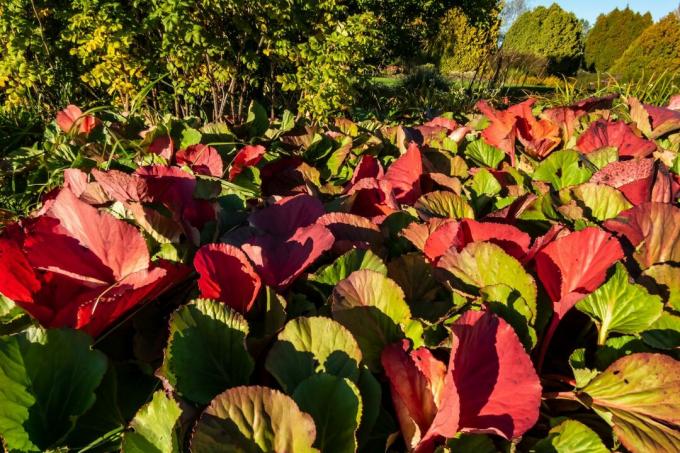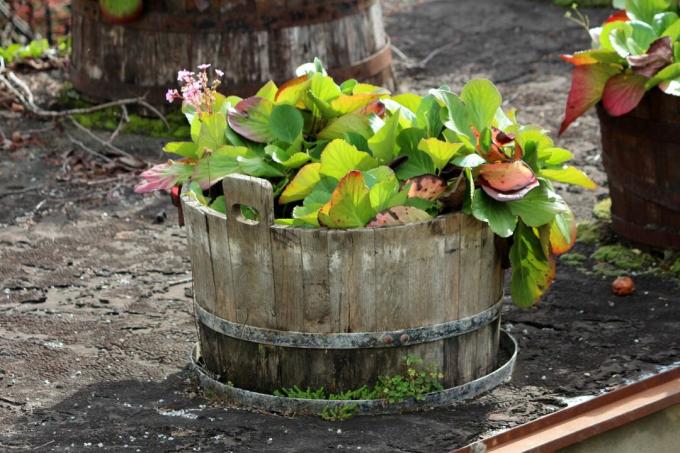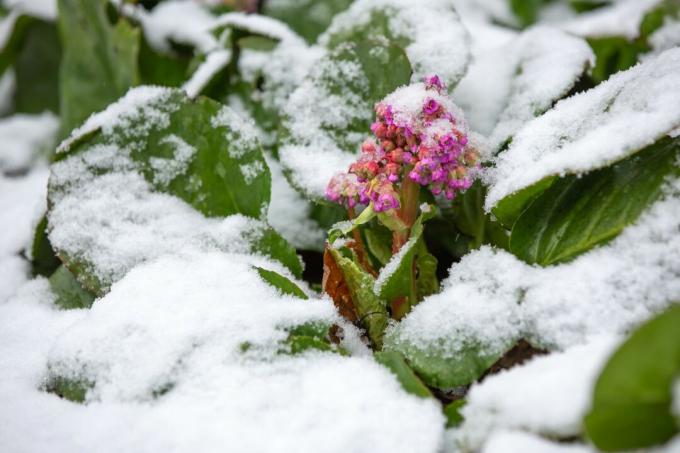In winter, the extraordinary Bergenia shines: the colorful autumn colors remain throughout the winter. It forms a harmonious play of colors with snow and frost.

Bergenia (Bergenia spec.) not only have beautiful flowers and leaves, but are also easy to care for and hardy. This is precisely why the Bergenia was voted Perennial of the Year in 2017 and has been found in gardens more and more since then.
contents
- Bergenia: flowering time, origin and properties
- The most beautiful Bergenia varieties and species
- Plants: location and procedure
-
Caring for Bergenia
- Bergenia does not bloom: what to do?
- Are Bergenias hardy?
- propagation of bergenia
- Are bergenias poisonous?
Bergenia: flowering time, origin and properties
Bergenia are often referred to as dextrose or giant saxifrage and belong to the saxifrage family (Saxifragaceae). The Altai-Bergenie (Bergenia cordifolia) is a naturally occurring species and is mostly used for breeding. In Europe, in addition to the original Bergenia, you can also often find hybrids that have emerged from breeding. The leaves of the Bergenia are about 35 cm in size, rounded and rich green. They are spirally arranged, short-stalked and evergreen. The beautiful autumn coloring in red, bronze and violet tones lasts until spring and makes the Bergenia a must-have in the winter garden. When the bergenia blooms from April to May, strong flower stalks are formed, which push out between the leaves. The flower stalks are 30 to 40 cm long and have a richly branched, coiled inflorescence. Depending on the variety, the flowers are white, pink, violet or red. After all, they offer a moderate supply of pollen and nectar for bees, bumblebees and other insects.

tip: Bergenia flowers can be used as cut flowers and provide a nice, textural contrast to other flower forms.
The most beautiful Bergenia varieties and species
The most popular varieties of Bergenia include those that show a special leaf color or flower.
- Bergenia cordifolia: This species is quite common on the market. It is also known as Heartleaf Bergenia. It is a fairly robust and easy-care Bergenia species.
- Bergenia purpurascens: This species develops an even more intensively colored foliage in autumn than Bergenia cordifolia.

- Bergenia crassifolia: One of the most beautiful wild species is the thick-leaf bergenia, which is also used to make Siberian tea. You can use them, for example, in the rock garden.

- Bergenia cordifolia 'Snow Queen': The initially bright white flowers turn to a soft pink after a short time. This spectacle is a great combination with the evergreen leaves.

- Bergenia cordifolia 'eroica': The intense red coloring on the underside of the leaves in autumn makes this variety special. Due to the robust stems, their inflorescences are particularly suitable for use as cut flowers. The flowers are red-purple.
- Bergenia cordifolia 'Babydoll': With this variety, the name says it all, because it remains small, compact and only about 25 cm high. Its flowers are light pink.

Plants: location and procedure
Bergenias thrive in a shady spot that's not too dark, but bloom best in a sunny spot. In general, Bergenia are undemanding, they can be planted in the rock garden as well as in open spaces and on the edges of trees. The soil should be rich in nutrients, humus and skeletal, i.e. coarse-grained and permeable. Moderately dry or fresh soil is ideal, as bergenia generally tolerate drought better than high humidity. When planting, it should be noted that a sufficient planting distance of 35 to 40 cm is allowed, as bergenias become wider over time. You can plant about five plants per square meter. It is best to plant the Bergenia in the spring. Here's how to do it:
- Dig a planting hole about twice the size of the root ball.
- If necessary, touch up the floor, for example by using our Plantura organic potting soil is added. It is coarse and yet humorous, which corresponds to the location requirements of the Bergenia.
- Use Bergenia. The plant can sit a little lower than when it was in the pot.
- Fill in the gaps with soil and press down carefully.
- Water well.

Likewise, bergenia can be cultivated in a pot. The vessel should then have a volume of at least ten liters. For pot-keeping it is best to use a loose, humus-rich substrate, such as ours Plantura organic potting soil. Our organic soil is in the slightly acidic pH range and naturally contains all the important nutrients, creating ideal starting conditions for the bergenia. Creating a drainage layer for water drainage is highly recommended for pot culture.
Combine bergenia: Bergenia can be combined with other Bergenia wild species and hybrids as well as ferns and grasses such as sedges (Carex) or bearskin grass (Festuca) combine.
Tip: Tree trunks and rocks in the background create a beautiful overall picture together with bergenia, ferns and grasses. Bergenia often overgrow stones and wood.

Caring for Bergenia
Bergenia are extremely easy to care for. In spring, brown leaves can be cut off to create space and light for the new shoots.
Since bergenias need nutrient-rich soil, they should be fertilized regularly from spring to autumn. So that you don't have to apply fertilizer weekly, a fertilizer with a long-term effect such as ours is ideal Plantura organic flower fertilizer well suited. It is lightly worked into the soil and soil organisms then gradually release nutrients which the bergenia absorbs. The fertilizer lasts for several months, so that fertilizing in the spring is sufficient for the entire year.
Bergenia in pot cultures should be watered regularly, but do not need too much water. For outdoor crops, it is sufficient to water during a prolonged drought, but even a short dry spell cannot harm the Bergenia.
Tip: After a few years, old stands of Bergenia can look bare because no new leaves are formed at the base of the creeping stem shoots. To prevent this, it helps to injure the creeping sprouts with a sharp object like a spade every year. The injury sets off a hormonal chain reaction that causes new leaves to sprout. A vigorous pruning or picking up and dividing the plants also ensures a more vital, dense and handsome growth.
Bergenia does not bloom: what to do?
Although bergenias are quite hardy, it can still happen that a bergenia just won't flower. This can have the following causes:
- Wintering: If potted bergenias are overwintered too warmly, they may not flower in spring.
- young plants: Young Bergenia need 12 - 24 months until they form the first flowers after propagation.
- Too shady location: If it is too dark, the Bergenia should be transplanted to a sunny location.
- Too much fertilizer: Over-fertilization can also lead to a lack of flowering. If none of the other causes mentioned above apply, you should reduce the amount of fertilizer.
- waterlogging: Persistent waterlogging leads to root rot, which kills the plant. Therefore, you should make sure that water can drain well.

Are Bergenias hardy?
In general, Bergenia are hardy and evergreen. Bergenia cordifolia even withstands temperatures down to – 35 °C. However, frost damage can occur on some leaves. If they are perceived as disturbing, they can be cut away in the spring. From autumn onwards, Bergenia should no longer be fertilized and cut so that they can survive the cold season well. How to hibernate Bergenia species-appropriate:
- Leave bergenia outside in the bucket in winter and wrap with fleece.
- In spring you can cover flower buds with brushwood or fir branches. The protection is only removed just before flowering to protect them from late frosts.

propagation of bergenia
There are several ways to propagate Bergenia. The simplest method is this division the mother plant. The healthy and strong mother plant is dug up in summer, the root ball with a sharp knife or spade and put the partial plants back in a suitable location planted.
In order to get more young plants from the propagation, one uses in autumn rhizome cuttings for propagation. You can use old, leafless rhizomes for this. They are simply dug up and stabbed. Cut the rhizomes into 4 to 5 cm long pieces and press them into potting soil, for example in a pot, about 5 cm apart. The roots should be oriented downwards and it is better to shorten roots that are too long. The upper half of the rhizome cutting sticks out of the ground. The substrate is now well moistened and set up at around 21 °C. If you keep the humidity high with a cover, then after ten to twelve weeks transplantable young plants will emerge that will flower in the next season.

Alternatively, the propagation is through sowing possible. This sometimes results in hybrids of different varieties or even species when different bergenias are planted next to each other, because they hybridize relatively easily. For propagation, the seeds must be collected from the withered inflorescences in summer. In the spring, the seeds are placed in trays with potting soil such as ours Plantura Organic Herb & Seed Soil distributed. Due to our nutrient-poor soil, the young plants form strong roots. Our substrate is also peat-free and particularly permeable, so waterlogging does not occur so quickly. The seed is not or only slightly covered with soil, then it is about light germinator. Place the trays in a light spot at around 21°C and keep the substrate moist. Seedlings can be expected after about four to six weeks. After germination, the bergenia are placed a little cooler, at around 15 °C. Here they can form more leaves and then be planted outdoors. The young plants will only flower for the first time after two years.

Are bergenias poisonous?
No, Bergenia are not poisonous. Bergenia crassifolia is used medicinally in Russia, Tibet and Mongolia and is also being researched here. Because it contains the hydroquinone arbutin, which in large quantities is liver-damaging and possibly carcinogenic and mutagenic, bergenia should not necessarily be consumed regularly.
The Bergenia is the ideal plant for a rock garden. Like you one Build your own rock gardenand which plants are still suitable for this, you can find out in our special article.


